Meanwhile the wild geese, high in the clean blue air,
are heading home again.
Whoever you are, no matter how lonely,
the world offers itself to your imagination,
calls to you like the wild geese, harsh and exciting –
over and over announcing your place
in the family of things.
Mary Oliver, Wild Geese
Walls have ears. List'ning to the tale that this wall
Tells from one side of our sectarian sprawl.
A tale told in blood, to the restless music
Of the ceaseless Rave which floods the double-deck
Of the next-door house, commandeered for evil.
The commander-in-chief is a muscle devil.
Here, each rented row is chimney-topped, each row
A funneled Titanic from the shipyard show
That is Harland & Wolff, not more than a stone
Throw away, down the Crum, and across the town.
Adrian Rice, Walls Have Ears
In 2017, BBC NI environment correspondent Conor Macauley published a report on the thousands of greylag geese which had flocked yearly from Iceland to a Belfast council estate. The geese, the piece reveals, grazing on scraps thrown out by residents, were ‘afforded a particularly potent layer of protection’, not by a conservation group, but the local unit of the loyalist paramilitary organisation the Ulster Defence Association (UDA).
The article continues the trend of media fascination with loyalist husbandry in north Belfast, where animals owned by certain figures attain legendary status: the toothless lions kept by ‘Buck Alec’ Robinson (1901-1995), the beloved Alsatians, Rebel and Shane, of Johnny ‘Mad Dog’ Adair (1963-), and the pair of chihuahuas, Bambi and Pepsi, owned by the late Sammy Duddy (1945-2007).
The ironic thrust of Macauley’s piece rests upon on the assumption that an armed and largely reactionary militant group – responsible for over 260 recorded killings during the Troubles, and currently involved in criminality – is incapable of invoking ecological ethics. Today as new houses go up on the estate, the geese no longer winter there. But still fascinated by their yearly return over the past decade, and intrigued by the lyrical potential of their relationship with the district, I wonder: what’s the meaning of these geese?
The rumour that tourists who come to see political murals in working-class Belfast are ‘safeguarded’ by paramilitaries lends itself to a cynicism where we guess that somebody, somewhere, is making a profit. But why protect these geese? The article’s subtext alludes to how the greylags were territorialised. In a place ostensibly closed to the outside, their presence was okayed by people with no mandate to warrant such an assurance.
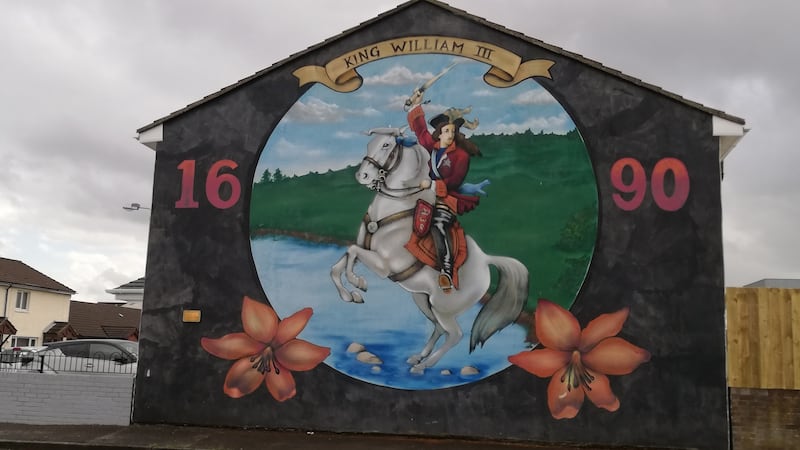
Regardless of the report’s critical nuance, however, I’d contend that by presenting a positive narrative where one can’t exist, the geese story has the capacity to destabilise moral and ideological predispositions, to rupture what French thinker Jacques Rancière (1940-) calls le partage du sensible, the apportioning of ‘what is visible and audible within a particular aesthetico-political regime’.
Owing to two centuries of systemic negligence and recent paramilitarism, the inner-city district where the BBC story is set, historically called the Old Lodge and now referred to locally as the Estate to differentiate it from the Shankill Road and environs proper, is one of the most deprived in Belfast. Despite its relative academic obscurity, this district has been at times the nucleus of the province’s tumultuous and contested history.
Reporting on the 1886 Home Rule riots, the Leeds Mercury counted ‘fifty people […]injured’ and two people shot dead by police in the area. In 1899, the Army’s Royal Irish Rifles and North Staffordshire Regiment were deployed in order to quell clashes. As the 1920s Troubles flared, the Old Lodge Road was described as the ‘storm-centre’ of violent disorder (Belfast Newsletter). Throughout the 1935 Belfast riots, 11 people were killed and nine men from the ‘Hammer’ – a neighbourhood which takes up over half of the district – were charged for unlawful assembly (Irish Examiner). And the Old Lodge district was the setting of the first high-profile sectarian killing of the recent conflict, the murder of Catholic barman Peter Ward on Malvern Street in June 1966.
I lived in the Hammer when I was a child. Some of my family live there still. Although we moved when I was in primary school, the place will always be home to me, my primal scene. Our street, the optimistically named Hopewell Place, is a cul-de-sac for cars but not people, with various entries running off it. Most notable of these entries is ‘the Lane’, which runs west – past the primary school, the nursery school, and playing fields – out onto Agnes Street, a stretch traversing two of the city’s arterial routes, the Shankill Road and the Crumlin Road. These three thoroughfares along with the Westlink dual carriageway to the southeast comprise the limits of the contemporary Estate.
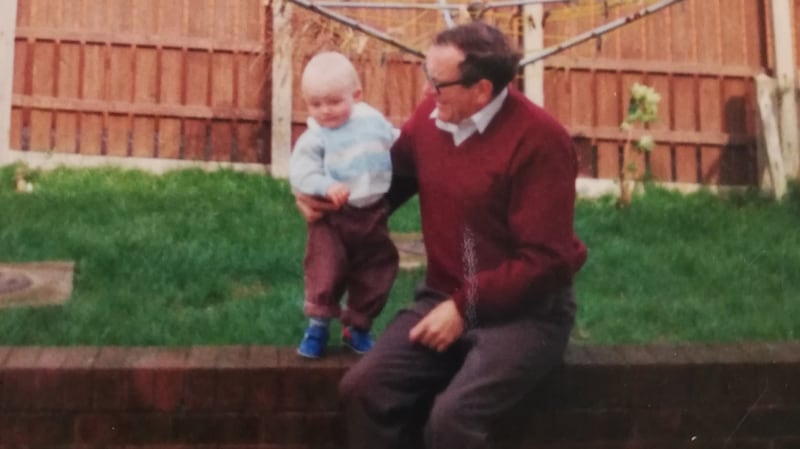
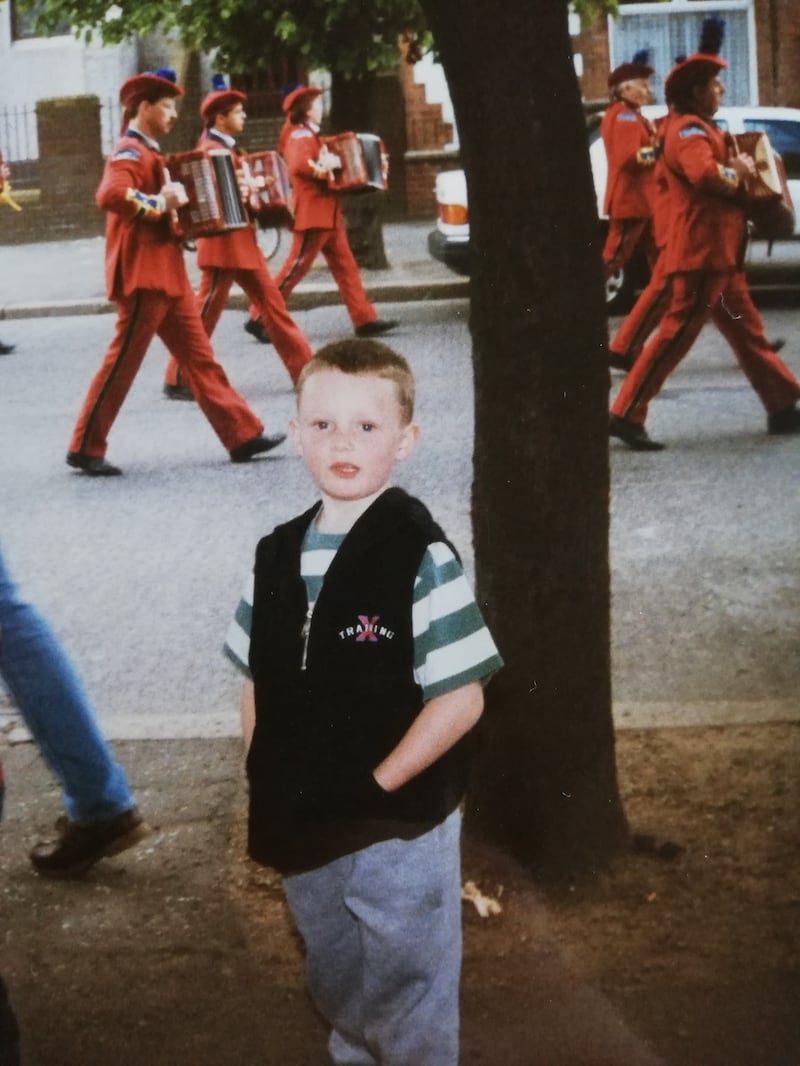
There were always pigeons and seagulls, but never geese, when we lived there. The streets of the Hammer were considerably livelier in the early 1990s than they are today. The kerbstones were painted the typical red, white and blue, bunting in the same trichromatic swayed throughout the year and, of course, there was a miscellany of flags tied to lampposts and draped from staffs above residents’ front doors.
Hundreds of mongrels were put out in the morning and let in at night: dogs of every shape and colour with nothing about them conforming to a pedigree, each with their own vivid temperament which every neighbour seemed to know intimately. After school, children played football, rounders and hide-and-go-seek. British army patrols traversed the district daily, usually en route somewhere else or on regular beat, but sometimes on exercise. It wouldn’t have been strange to look out the window and see a camouflaged back in your front garden at any time of the day. You could walk right by a crouching squaddie on your way out the front gate to work or school. I recall one with a hackle (feather plume) in his cap letting me look through the scope of his SA80 assault rifle.
I remember this recurring dream: a policeman's on his way to arrest and question me, to leave me to rot in 'the Crum' – the prison less than 200 yards from our house
I didn’t see any geese, but I remember this recurring dream: a policeman’s combination cap bobs above a wall, back and forth – he’s looking for someone … me; he’s on his way to arrest and question me, to leave me to rot in ‘the Crum’ – the prison less than 200 yards from our house. I’d go shopping on the Crumlin Road with my mother, a stretch which then (and until quite recently) had an aura of what I can only describe as doom about it. One time, as we walked past the gaol on our way to the butchers, we witnessed a prisoners’ protest.
They were on the slate pitched roof; some crept along the ridge like tightrope artists, others sat in the gaps where tiles had been smashed in. Some were lobbing tiles down at the policemen and soldiers watching amused from the road below. They looked happy, the prisoners; stubbly, tired, but happy. I asked my mother why they didn’t escape while they had the chance. She said she didn’t know. Sometimes when a prisoner had escaped, they’d sound the World War Two air raid siren, which on greyer days must have been alarming to the Estate’s older residents and their film buff grandchildren.
We lived under the cosh of paramilitarism, but this had by the 1990s become a familiar cosh. Things were normal when settled, when life seemed stable, as things are everywhere. As is common in lower-class communities across the Global North, throughout the year some older kid would lift a manhole cover and burst the water main to create a 10ft fountain that we’d dance through.
One of the by-products of paramilitarism is an ostensible level of street safety. We knew instinctively to never leave the area alone, and sensible strangers knew to never come in.
It was certainly no place for flocks of unaccustomed migratory birds. I would have happily thrown stones at a goose then. We threw stones at each other for fun, as the scars on my forehead attest. One of the by-products of paramilitarism is an ostensible level of street safety. We knew instinctively to never leave the area alone, and sensible strangers knew through repute and practice to never come in. The furthest I got was the youth club on Denmark Street at the north-easternmost corner of the district. I didn’t attend – having a visceral antipathy towards strictly organised ‘activities’ – but the surrounding area used to flood with heavy rain, so we’d build wooden rafts from the teenagers’ bonfire hoard.
Children would go out to play from around the age of three. They’d be sent to the shop for what was needed: a loaf, brown lemonade, potatoes, 10 cigarettes. Our nearest convenience store was ‘the van’, an illegal sweetshop-cum-tobacconists operated from a wheel-less blue box truck in the front garden of a house on Florence Square. Conveniently, a man would also drive around in a Vauxhall Cavalier at night, stopping every few streets to sell all manner of things from its boot – from videotapes, to firelighters, to tampons.
Truant boys would knock doors of a weekday afternoon and try to peddle their booty – toys stolen from Woolworths and Leisure World. My mother used to say she felt sorry for them. My first Lego set was a raft with pirates, my second was a Robin Hood scene with Robin himself and two Merry Men posing at their tree HQ; this is even less believable and just as true as the fact that my fervidly law-abiding grandmother on my mother’s side, who lived a few doors down from us, once bought from a car boot a pirated copy of Andrew V McLaglen’s The Wild Geese (1978), starring Roger Moore as suave international mercenary Lieutenant Shawn Fynn.
Before I reach for my violin, I should say that I was lucky. They sent me to the good school, Cliftonville Primary, which was officially ‘integrated’ but attended mainly by Protestant children. We were Protestants, just about. The local Anglican church, St Michael’s, was used before the real event of the drink-fuelled afterparty of christenings to give proceedings a slight whiff of spirituality rather than respectability.
I was sent to Sunday school on only a few occasions. The man who drove the bus was a bag of nerves and would shout in the children’s faces. I had to be restrained one Sunday morning when I caused a scene after trying the church hall door handle to find it locked. I wanted to go home. How strange I must have looked to the congregation, with my curly blond hair and rosy cheeks, an angel bawling and cursing in the House of the Lord, the Immanuel Presbyterian Church on Agnes Street. Nobody in the area ever got married. My parents didn’t, and I wasn’t christened either. Christmas was for Santa Claus – usually my father’s friend Big Roy with a goose-feather pillow up his red jacket – the God of Plastic Commodities and Noddy Holder’s raspy Walsall voice: Do the fairies keep him sober for a day? Parents spent more than they had, got into debt even, buying presents for their kids. They were sprawled over the sofa on Christmas Day. In school, they made us sing Once in Royal David’s City and dress up as shepherds, wise men and sheep.
My grandfather on my father’s side would pick me up on Friday afternoons, and we’d buy nectarines from the fruit shop or potted herrings from the fishmongers to eat in the park, whether it rained or not. As I said, I was lucky. We’d stop off at the Carnegie library to take out books to read when we got there. He’d go for something on the Spanish Civil War; I loved Barbara and Ed Emberley’s Drummer Hoff (1967) and Dick Roughsey’s The Giant Devil Dingo (1973). We’d walk the mile or so uphill to Woodvale Park with our books and nectarines, and when we arrived – beyond the bandstand and the bowling green – a bevy of fluffy dirty-white swans would be sailing around the pond; but I don’t recall seeing thousands of greylags on the grass. When we finished reading our books, I asked him hundreds of questions.
Before the ‘slum clearances’ (1968-1974), the Old Lodge district had mainly comprised a familiar grid of redbrick kitchen house terraces such as those of the industrial north of England. Although only half-a-mile from the town centre, at the turn of the 19th century the area remained largely unurbanised. The arrival of migrant workers from rural parts of the country coming to work in the linen mills, many of whom had escaped An Gorta Mór, saw the population of Belfast – which was no more than a village in the early 17th century – soar from 53,000 in 1831 to 115,000 in 1853.
During this time, between the arterial routes of the Shankill Road and the Crumlin Road foundries were busy. New brick was left out to cool on land soon to be covered with ‘rows of tightly packed two-up-two-down’ houses, which for thousands of years had been a grazing place for cattle, attended in the late autumn by flocks of greylags. The upper end of what is now North Street, running northwest from Belfast’s centre, was once named Goose Lane – a nomenclature which indicates that before the 19th century, wintering geese had been a fixture in the town’s calendar.
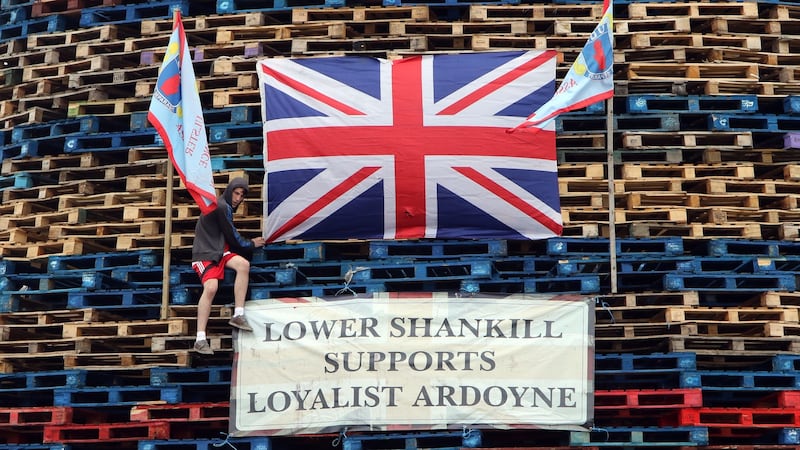
Throughout most of the 19th and 20th centuries, there were no wide, grassy spaces in the Hammer to graze on. Prior to redevelopment, barring a piece of waste ground unimaginatively called the ‘Waste’ and the gravel football pitch-turned-playpark, there was very little unused space, never mind an unused grassy space. Owing to on-pitch brutality, the local football team that played on the gravel pitch earned the nickname ‘Sledgehammer United’; the pitch being their home venue, it became ‘Sledgehammer Park’; when the city corporation built a playpark on the plot where the pitch had been – perhaps to put an end to gory bouts – this name was shortened to the ‘Hammer’. The streets east of the swings and climbing frames eventually took this name.
Ron Wiener's The Rape and Plunder of the Shankill (1976) details the governmental maladministration and corporate corruption that hung over the late-sixties redevelopment
Ron Wiener’s The Rape and Plunder of the Shankill (1976) details the governmental maladministration and corporate corruption that hung over the late-sixties redevelopment, which he characterises as a ‘horror story which just ran and ran’. The streets were redrawn. Once one of the city’s arterial routes, the Old Lodge Road – which ran diagonally through the eponymous district from the junction of Agnes Street and the Crumlin Road southeast towards North Street – was cauterised at the back of the courthouse at Florence Place and redesignated a street.
Apart from two dozen houses on Forster Street and Malvern Street (which still stand today), the terraces were levelled. In their place, typical late 20th-century-style council housing and blocks of flats went up. Catholic and Protestant neighbours were separated by the Westlink dual carriageway, ossifying local sectarian disintegration. Many families moved to the suburbs, others to Australia, South Africa and North America. Many young fathers left to work in Great Britain and never returned. Commercial premises along the Old Lodge Road and Agnes Street were demolished. The local economy was decimated.
Prior to redevelopment, facilities had generally ‘met the living needs’ of inhabitants. ‘There were numerous shops and […]meeting places such as pubs and halls’, but redevelopment ‘greatly reduced’ the number of premises from around 70 to 12 ‘in a community of some 3000 people’.The number of shops were reduced due to a planned district shopping centre which was never built. The removal of amenities such as ‘coal dealers and scrap dealers’, Wiener writes, accommodated ‘an economic strategy based on the needs of large industrial corporations’. The motives of the ‘authorities’ were ‘diametrically opposed’ to the interests of ‘working class communities’. This situation persisted when we lived in the Hammer, and persists still. Within the Estate today, there’s one corner shop, two petrol stations and a few small businesses on the periphery.
Populated with indifferent political charlatans, damaged war veterans and semi-feral preteen children, Simms' Hammer wasn't unlike its late-'80s palimpsestic heir
John Young Simms’ memoir Farewell to the Hammer (1992) recounts his upbringing in the district from the mid-1920s through the Hungry ’30s. Simms describes the depressed but content existence of a dispossessed and disenfranchised community afflicted with sporadic bouts of sectarian violence. Populated with indifferent political charlatans, damaged war veterans and semi-feral preteen children, Simms’ Hammer wasn’t unlike its late-’80s palimpsestic heir, the council estate where I spent my first years. He might have disagreed with such an assertion, however.
My maternal grandmother, born in 1929, was reared in the old Hammer, in a kitchen house on Conlig Street. They’d have porridge three times a day most days, porridge pie sometimes, or boiled rice with raisins. On Sundays they had soup made with celery leaves, carrots, barley and a shin bone. At Christmas they got an orange (as the cliche goes) and, of course, chocolate. Nobody in the old Hammer ever bought a goose for the holiday season. Having moved away before the ‘slums’ were cleared, Simms’ memoir ends with a mournful account of his first visit to the newly-built Estate.
‘I was lost in the Walks and confused in the Ways,’ he writes, ‘the bulldozers had removed forever the old tumbledown houses’ and ‘gouged out the heart of the place’. As he ‘roved around’ what was for him with its pebble-dashed walls and barking dogs an ‘alien quarter’, he writes that even the ‘starlings’ mocked him ‘from the tower of St Michael’s’, but makes no mention of geese.
After redevelopment, in contravention to its objectives, further social deprivation ensued. Wiener writes that in the old Hammer, because ‘the street was seen to be an extension of the house [it] belonged to everyone in the neighbourhood’; it was thus difficult ‘for anyone to commit delinquent actions behind the cloak of anonymity’. The corridors, courts, and staircases of the new six-storey blocks locally known as the ‘Weetabix Flats’ (which were ‘full of rubbish and dog shit’), ‘became free play areas for young people [who] for example [started] throwing objects over the edge [–] including a jack handle which fell on a woman’s head and she had to be rushed to hospital’.
It’s important to remember that Wiener was writing this less than two years after the redevelopment’s completion. I remember being in the Weetabix Flats in the early 1990s with my brother. Their concrete forecourts and quadrangles were perfect for playing Duck, Duck, Goose. Even as a small child, I recall being surprised, pleasantly surprised, at the chaos of the flats. Shouting-matches and the din of crying babies were constants in the background. Everyone left the doors of their maisonettes open and we would wander in and out as we pleased. None of the residents ever asked who we were or what we thought we were doing. There would often be a gaunt, tired-looking man spread over an armchair smoking in the living-room, sleeping-bags on the floor, plastic cider bottles lying around. In such instances, we’d turn back and try the next door along the deck access corridor in our search to find the home of our new best friends who were playing a Commodore 64 or an Atari. I’d get goose bumps at the prospect.
Because something very very bad had happened, out of the blue my brother and I were ordered one day by our mother to never visit the Weetabix Flats again. If, as Wiener writes, ‘social control’ on the new Estate was already diminishing by the mid-1970s, two decades on, the situation had deteriorated still. The six-storey blocks, which were mainly inhabited by damaged young adults of the community, had by the 1990s become emporiums of a new type of entrepreneurialism.
Unemployment crises, funding cuts, the testosterone-fired moral fugue of the Troubles, the 'breakdown' of community 'ties' following the '70s redevelopment, brought about the perfect conditions for a new form of ultra-paramilitarism
Unemployment crises across the archipelago, government funding cuts, the testosterone-fired moral fugue of the Troubles, mixed with the ‘breakdown’ of community ‘ties’ following the ’70s redevelopment, brought about the perfect conditions for a new form of ultra-paramilitarism by the early 1990s. Engaged in all manner of gangsterism – ‘shebeens, drug flats, brothels, extortion rackets, robberies’ – these up-and-comers, epitomised by the UDA’s then C Company, under the command of Johnny Adair, made their presence known by commissioning a new series of menacing murals and stepping up violence against Catholics.
From the early 1970s to the present day, numerous community initiatives have existed beyond paramilitary infrastructures. A host of grassroots associations have been successful in limiting the worst of unconsulted housing redevelopment; social schemes – such as youth clubs, parenting support groups, and anti-drug campaigns – sought to and did curtail further social deprivation. But given the disconnect between communities and political structures, between people and policy, ‘community development work was like pushing a big rock up a hill’. Jackie Redpath, one of the central figures involved in these initiatives over the past four decades, has said in interviews that given the political backdrop, community workers were always working ‘against the odds’ because ‘the Troubles could undermine what you were doing’.
When I was young, the Shankill Road on Saturday afternoons was always packed with shoppers. Many were there for the nostalgia, they or their parents having moved away during the redevelopment. My father and I would take the Lane most weeks up to ‘the Road’, which invariably meant long spells in the smoky bookmakers, followed by the payoff of a packet of crisps and a bottle of Coke in the pub.
On one such Saturday afternoon in October 1993, we were in the card shop. Daddy had tasked me with choosing a birthday card for my grandfather. Someone had rented a bus so that the whole family could be driven out to my uncle’s house in rural Co Antrim. I was excited. Doagh was another universe where people went for long walks for the sake of it and took wicker hampers into fields to eat hard-boiled eggs on tartan quilts.
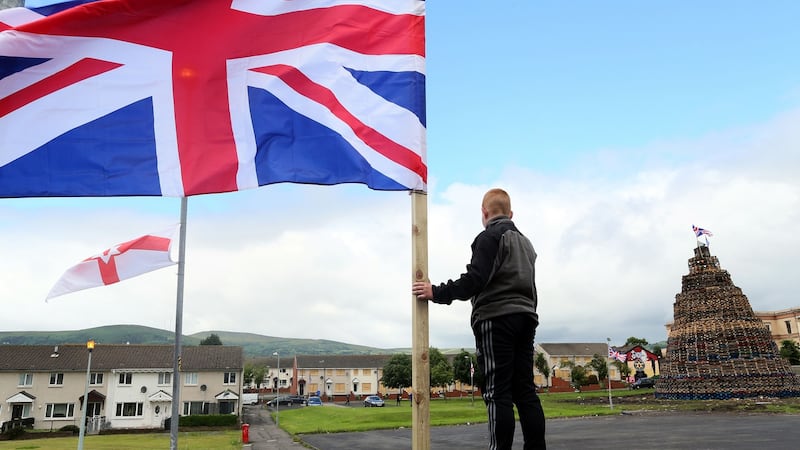
Sawdust chips like those I'd kick about the butcher's floor came down at the rate of snow. Hands and jeans flitted in and out of the mortar dust fog like goldfish in dirty water
The sound too much for my six-year-old right ear, I heard only a short phut like a fucked football under the wheel of a car. I wasn’t frightened, until my father let go of my hand. He wrestled his way past the other customers and moved through the door to the pavement. The last in the shop, I hmmed and hahed – but I needed to go to the toilet, so I went out. Sawdust chips like those I’d kick about the butcher’s floor came down at the rate of snow. Hands and jeans flitted in and out of the mortar dust fog like goldfish in dirty water come to kiss the glass of their bowl. They dodged me as they came and went, in and out of the grey. I needed to go to the toilet. As the wind cleared the air, I saw a rush of black soles, white soles, perms, curtains, baubles, baggy shirts and baggy jumpers. They were running uphill towards it. I needed to go to the toilet. My father swooped out of the murk, picked me up and followed them.
None of the adults spoke on the bus to Doagh. We moved out of the Estate into the suburbs a few miles north not long after the Shankill Bomb. Ballysillan, though leafier, was just as entangled in the petty social mechanics of the Troubles. The children of our new street seemed naive and gentle – wouldn’t have said boo to a goose – which suited and probably softened me. I didn’t leave the house much. We’d take the bus weekly to visit family in the Hammer. Afternoons on the Shankill Road were less jovial after the carnage of October 1993.
Two years after the Good Friday Agreement, the BBC reported an ‘exodus’ from the Estate. By the end of the year 2000, a bloody intra-loyalist feud instigated by Adair’s C Company had claimed the lives of a dozen men. The district became once more the ‘storm-centre’ of violence in the city. Hundreds of families, whose houses had been subjected to machinegun and petrol-bomb attacks, were forced to leave. In 2002, amidst the second loyalist feud of the century, the leading members of C Company were expelled from the UDA by the organisation’s ‘inner council’.
Given the revelations into collusion between British security forces and C Company, we might contend that their expulsion forms a late-modern analogue to the Flight of the Wild Geese
After Adair was imprisoned in January 2003, his supporters were exiled to Great Britain where, harboured by neo-Nazi militants, they continued their various criminal exploits. Given the increasingly public revelations into collusion between British security forces and C Company during the final years of the Troubles, we might contend that their expulsion forms a late-modern analogue to the Flight of the Wild Geese, the martial conclusion to the Williamite War in Ireland (1688-1691).
In October 1691, William of Orange defeated his uncle and father-in-law James Stuart to take the Kingdom of Ireland, having already secured England and Scotland during the Glorious Revolution of 1688-89. After the Treaty of Limerick, 14,000 Irish soldiers (the eponymous ‘wild geese’) who’d remained loyal to James fled to mainland Europe, where they were integrated into the armies of France, Spain and Austria.
James Murphy asserts that the epithet ‘wild geese’, which has come to denote soldiers (as well as civilians) who’ve fled Ireland over the centuries, is ‘so entrenched in the Irish consciousness that it seems to require neither explanation nor quotation-marks’. Citing literature which references these Jacobites as a symbol of nationalist aspiration – from pre-19th-century Gaelic poet Seaghan Ó Cúinneagain to WB Yeats – Murphy asserts that the cultural memory of the messianic ‘wild geese’ has, in the intervening centuries, been used to reap ‘ideological capital’ from ‘Irish history’. Although the contemporaneous origin of the phrase is now lost, we can speculate that the exiled Jacobites were characterised as goose-like due to shared associations with migration and the promise of repatriation. The behaviour of wild geese then, we might crudely posit, can represent hope.
Although Troubles tourism is now a vital aspect of Belfast's economy, you'd struggle to find an elected representative who'd live within this particular attraction.
Conor Macauley’s 2017 report on the Estate’s ‘protected’ greylags (perhaps unwittingly) taps into the trope identified by Murphy, where the goose – because of its tendency to habitually depart and return, not to mention its hissy impertinence – mirrors the volatile ethnic flux of the Hammer’s history. Or maybe it’s just a hopeful story from a district which has had more than its fair share of hopeless stories since the laying of its first brick. Over the past few years, new houses have gone up on the Estate; it boasts a daily influx of tourists, who come to take snaps of the many political murals. Although Troubles tourism is now a vital aspect of Belfast’s economy, you’d struggle to find an elected representative who’d live within this particular attraction. To paraphrase that well-worn phrase which politicians are wont to use: is sauce for the goose ever sauce for the gander?
Redpath has spoken mournfully of how the loyalist feud of 2000 all but ‘destroyed […]a community’. Though he isn’t sure which elements of social cohesion might remain ‘intact’ within the district, there’s optimism in his description of the place as ‘a work in progress’. Susan McKay writes that after ‘decades of paramilitary dominance, in the early years of the new century the [Estate] was a desolate place. A local research project showed significant mental-health problems, high rates of assault against children in their own homes and a level of education attainment that ranked among the lowest in the UK. Less than 1 per cent went on to further education.
By the middle of the first decade of the century, the last of the late-’60s redevelopment flats had been torn down. Grass had grown on the acres of empty space and, as there weren’t so many children to play on it, one November the geese returned.
A Superking
with a three-inch cinder hangs from the gub of Old Cormac
as he sweeps a river of bleachy water
from the entry out to the street. Next thing
it's dandering towards him – the cheek of it. A big honk
blowing from its orange bill,
its tongue quivering like a storm-mangled banner.
Cormac admires its feather tunic made of every grey there is
from blinding light to deepest dark.
He thinks of analogue TV static, wet tarmac lit up in the sun
but not the cinder from his cigarette
as it tumbles down his dressing gown. It dawns on him –
the water! Bleach could burn those orange feet.
He drops his brush to spook the thing.
He flicks his butt at it. It hisses. He laughs. He shoos a goose.
Scott McKendry was the recipient of the Patrick Kavanagh Poetry Award 2019 and his pamphlet, Curfuffle (The Lifeboat), was Poetry Book Society Autumn Choice 2019. He’s currently working on his first full collection. This essay first appeared in volume 22(1) of the Irish Journal of Anthropology in 2019.


















